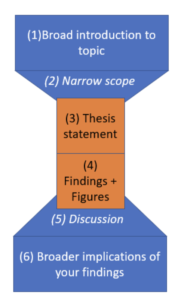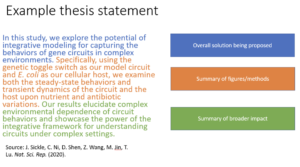Scientific writing can be a daunting task, and there tend to be many genre-specific rules for it. In this page, we will give a framework you can use to help write and organize your science document. While this page is written more with publications in mind, this advice also can be followed for lab reports, proposals, and other documents.
On this page
- Introduce a problem
- Narrow the scope
- Thesis statement
- Findings and figures
- Discussion
- Broader implications
The structure of academic science writing can be summarized in an I-chart, shown below. The scope is broad at the beginning and end but is narrowed in the middle of your document.

Image 1: I-Chart: The Structure of Science Writing
To summarize this structure:
- Introduce relatively broad ideas, i.e. discussing the field at-large and previous research that has been done in this field.
- Narrow the scope to introduce the exact problem you are examining.
- Provide a thesis statement to summarize your results and arguments. While the thesis statement itself is short, getting it right is one of the most important parts of a science paper.
- Include detailed, direct findings. This section is usually the longest part of a science paper. It generally includes data presented in properly formatted and captioned graphs and tables and appropriate discussion of uncertainty.
- Discuss implications of the findings. At this point, the scope should be broadened again to make clear the overall impact of your work on the field.
- Discuss the broader implications of your work and what future research can be done.
Part 1: Introduce a problem
The broad introduction part of your manuscript can generally be mapped to an introduction section. It is important to start with general statements and background information that can be understood by a general population; doing so makes your document more accessible and can thus help your findings have a greater impact.
One tip is to write the broad introduction such that each paragraph discusses a concept important for understanding your results. Think about what concepts need to be introduced in order to understand your thesis statement: a good introduction will ensure that these are all covered before you get to the thesis statement.
Part 2: Narrow the scope
Once enough background information has been given to properly introduce your problem, you should discuss previous solutions or ideas that have been proposed. It is also useful to discuss the downside and the benefit of these past approaches: this approach can help contextualize your solution within the field better.
One way to end this part of the manuscript is with a “however” statement. That is, you should show that prior studies have some flaw that your solution can address. You can also use this part to motivate a new method for examining an older problem, in which case you may wish to end with a “therefore” statement. The exact formatting here should be left up to your discretion, just keep in mind that you should contrast the previous results and those you present in your current manuscript.
Part 3: The thesis statement
Every manuscript, lab report, and proposal should have a clear thesis statement. The goal of a thesis statement is to introduce your proposed solution. Each figure/table should be thought of as a supporting argument for the proposed solution and is also included in the thesis statement, though discussed more broadly.
Some guides recommend the thesis statement should be a single sentence; however, we suggest you think about a whole paragraph as your thesis statement. Readers may get confused if there is too much information into a single sentence, so splitting the thesis statement into multiple sentences gives readers a better chance to digest the content.
The final sentence in your thesis statement should be a one-sentence overview of the broad implications of your results. These implications will be expanded upon in parts (5) and (6) of your draft, so no need to go into more detail than a single sentence.
Here, we present an example thesis statement from a published paper, with each portion highlighted.

Image 2: Example Thesis Statement
Part 4: Presenting your results
The bulk of your paper’s length should be committed to presenting your results. In science documents, these results generally take the form of figures or tables. Each of these figures/tables should be thought of as supporting arguments for your thesis statement. As such, when writing an outline, bullet points in the results section can be split up by figure, for example.
The first part of this section should focus on introducing the methods used and explaining where the data comes from. This can be anything from code that was used to other papers from which data were taken. Detailed information should be added to a Supplemental Information file. Some journals may require this information be added to its own Methods section, so please refer to the journal’s style guide for more information.
Most journals specify the style they require for figures and tables in a style guide. The style guide should be read closely. For broad information on figure style, please refer to our Style Guide for Figures in Science Writing.
Part 5: Discussion
This part should include discussion and interpretation of your findings. It should almost always begin with an overview of what was found in Part 4, similar to your thesis statement.
In-depth analysis of your findings should then be made; that is, make it clear to the reader what the consequences are of your presented figures. You can use this section to persuade readers (1) why you showed the figures you did, and (2) what these figures have to do with the problem you are trying to solve.
You can also use this section to refute potential arguments that readers may have regarding your findings. This can involve introducing further analysis or figures beyond what was shown in Part 4.
Finally, you can discuss limitations of your study. You should mention how a future study may solve issues with the current work.
Part 6: Broader implications
Finally, your paper should end with a look into the future. What are some implications of your research if the results are true? What are some future studies that can be done in this direction? Eventually, what is the impact this study could have in the context of the field and/or society at large? This section can be relatively short but is very important for persuading readers that your research is important.
